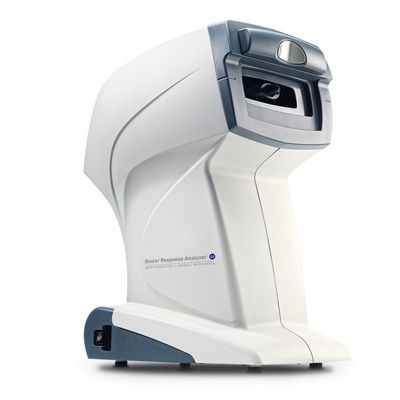

- Home
- Companies
- Reichert, Inc
- Products
- Model G3 - Ocular Response Analyzer

Model G3 - Ocular Response Analyzer
Ocular Response Analyzer® (ORA) G3 is the only device that measures Corneal Hysteresis (CH) and Corneal Compensated IOP (IOPcc). Corneal Hysteresis has consistently shown to be a more powerful predictor of, and strongly associated with, glaucoma progression, more so than key risk factors such as IOP and CCT. IOPcc is a pressure measurement that is less affected by corneal properties and more associated with glaucoma risk than Goldmann and other tonometers. Ocular Response Analyzer is engineered, designed, and assembled in USA.
Ocular Response Analyzer® G3 and Corneal Hysteresis:
Make a more confident glaucoma risk assessment, with Corneal Hysteresis. Only Ocular Response Analyzer® G3 from Reichert® measures Corneal Hysteresis (CH), a superior predictor of glaucoma progression, which is more associated with visual field progression than CCT or IOP.1,3,5 Ocular Response Analyzer helps add clarity to your glaucoma decision making process. CPT Code 92145, was published for the Corneal Hysteresis measurement provided by Ocular Response Analyzer.
Corneal Hysteresis Insights: ‘The Ophthalmologist’ Advanced Glaucoma Technologies Forum
Insights on the role of Corneal Hysteresis in Glaucoma management.
Taken from the Advanced Glaucoma Technologies Forum presented by The Ophthalmologist
“Hysteresis is a very powerful risk factor for progression of the disease, and I think it’s one that’s largely overlooked. In fact, if you take Hysteresis out of the central corneal thickness measurement, central corneal thickness might not even be a risk factor for glaucoma progression. Hysteresis is absolutely critical for estimating the risk.” – Robert Weinreb, MD.
Glaucoma opinion leaders Ike Ahmed, MD, E. Randy Craven, MD, Constance Okeke, MD, Inder Paul Singh, MD, and Robert Weinreb, MD, discuss the strides made in detection and management of glaucoma, and explain the benefits of measuring Corneal Hysteresis for glaucoma risk assessment. In this round table discussion, the doctors explain how Corneal Hysteresis aids them in better predicting glaucoma progression.
“Things like Hysteresis have helped me a great deal because it does give you an understanding of the quality of the IOP. In other words if someone has a low hysteresis with a high pressure I’m much more worried than having a high Hysteresis with a high pressure,” explains Dr. Singh.
- Catalog Number: 16170
- Dimensions: 26.7 W x 50.2 H x 35.6 cm D (10.5 x 19.75 x 14 in.)
- Weight: 10.4 kg (23 lbs)
- Voltage: 100/240 VAC Frequency 50/60 Hz
- Measurement Range: 7 - 60 mmHg (ISO 8612 tonometer standard)
- Communication Port: RS-232
